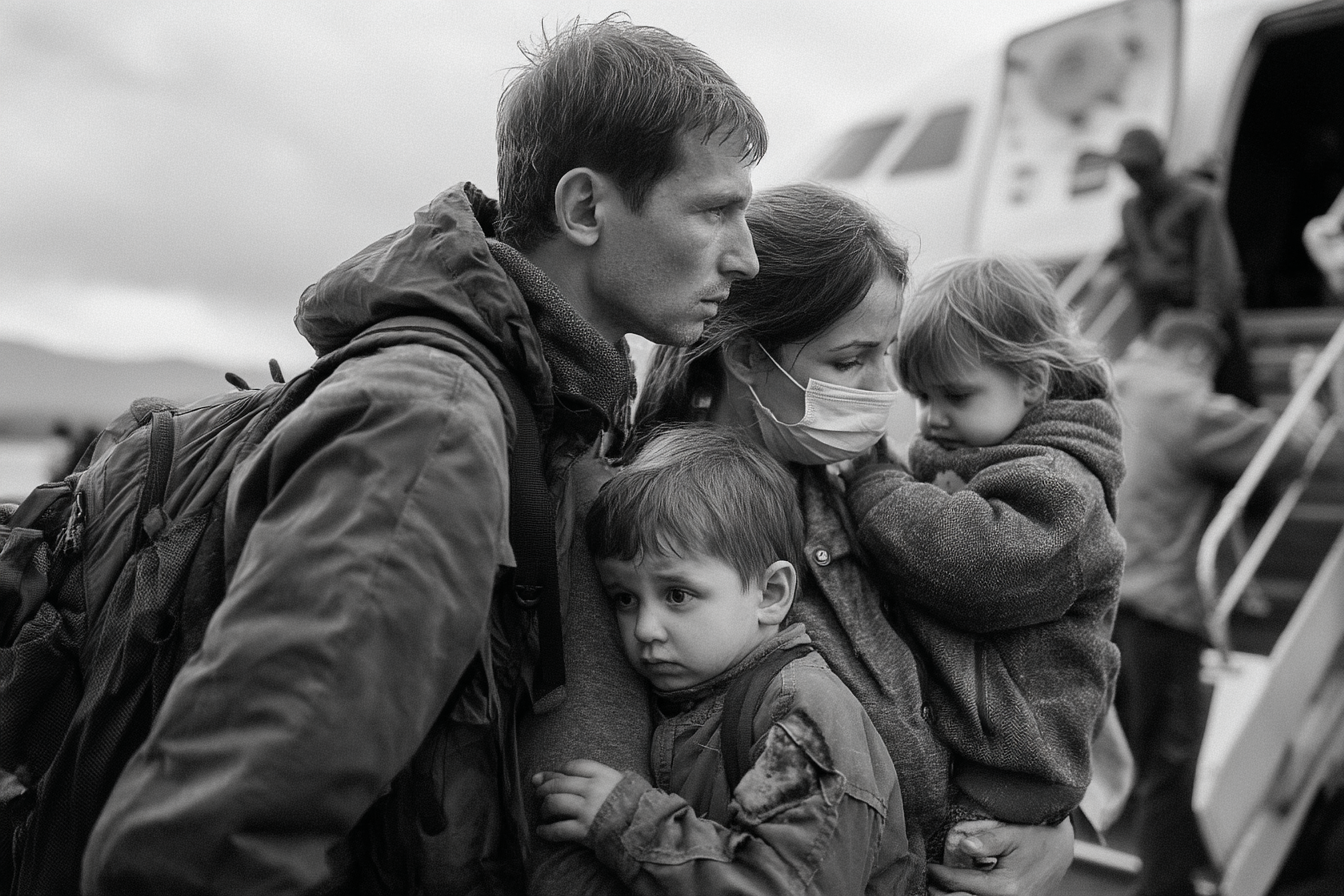Introduction
This article outlines an extremely unorthodox plan – The poorer nations of Europe attempt to reverse brain drain by offering educated, professional, law abiding americans a way out of authoriatrian collapse, police state, racism, prejudice, gun culture, political debt lock, personal and collectivized debt, and compete political recalcitrance and incompetence on part of the US elites. Yes, this is an offensive article for americans who still cling to ‘The American Dream’ and ‘American exceptionalism’. The US is no longer a pleasant society for majority of its people. The premise is simple – destination countries provide debt forgiveness by mass repudiation of US nationalities, by providing collective debt annulment through new identities, and by aiding and abetting these people walk away from their lives in the U.S. – completely, severing all ties. Yes, this is a bold plan with many moving parts.
But there is massive demand – Over a hundred million americans are right now looking at emigration. The main thing keeping them ‘locked on the reservation’ are FATCA banking laws, the predatory character of the US debt industrial system, and the aggressive stance of the US towards people ‘turning in their passports’. Take away those barriers and the whole house of cards collapses.
Chapter One
The Soft Underbelly
Southern Europe is often celebrated for its warm climate, vibrant cultures, and deep historical roots. Yet beneath this romantic veneer lies a set of persistent structural vulnerabilities—economic fragility, demographic decline, and political uncertainty—that are becoming increasingly difficult to ignore. Within the framework of what some have begun to call the “Southern Exit Strategy,” these underlying problems no longer linger quietly in the background; they are growing pressure points. And, paradoxically, they may also represent points of departure for transformation.
Greece remains emblematic of this broader tension. The country’s debt-to-GDP ratio continues to hover at unsustainable levels, even after a decade of austerity programs and successive bailouts. Youth unemployment remains stubbornly high, with roughly one in four young Greeks unable to find work. This has triggered a steady exodus of educated and ambitious young people, many of whom now seek stable futures in northern Europe. Entire rural regions have been left behind—villages stand empty, local economies have stagnated, and public services operate under constant strain. Greece’s reliance on tourism and shipping, while vital, offers little in the way of long-term stability or growth.
Spain, too, is still living in the long shadow of the 2008 financial crisis. The collapse of its real estate sector left behind a fragile financial system, characterized by shadow banking and an increasingly precarious labor market. Regions like Galicia and Andalusia have been hollowed out by emigration, while political turbulence continues to simmer—evident in both nationalist tensions in Catalonia and the steady rise of polarizing political movements. For Spain’s younger generations, the promise of opportunity often lies elsewhere, in northern Europe, where the employment landscape is markedly more forgiving.
Portugal projects an image of calm and quiet progress, but this belies a more delicate reality. The economy is heavily reliant on tourism and speculative foreign investment in real estate, leaving it vulnerable to global market shifts. While cities like Lisbon attract international attention, the country’s interior tells a different story—low birthrates, rural depopulation, and the gradual flight of educated youth suggest a long-term erosion of potential that rarely makes headlines.
Further east, Bulgaria and Romania continue to wrestle with the legacy of post-Soviet transformation. Since joining the EU, both countries have seen massive outflows of working-age citizens—entire regions have lost a third or more of their populations. Despite formal integration with the European Union, deep-rooted institutional weakness and endemic corruption remain significant obstacles. Economic convergence with the West proceeds slowly, and for many, the primary export continues to be labor.
Croatia presents a more recent example of these patterns. Its tourism sector has flourished in recent years, providing a much-needed boost to GDP. Yet behind this success lies a familiar set of problems: decaying infrastructure, a widespread exodus of young people, and an entrenched political class unable—or unwilling—to implement structural reforms. Much of inland Croatia is now economically stagnant, and its relevance within the national economy is steadily eroding.
But — there may be an easy fix.
These nations don’t need to conjure new industries out of thin air, nor do they need to spark sudden, miraculous growth. The opportunity is already arriving—on its own, quietly, and with growing urgency.
A wave of young, educated, and increasingly disillusioned Americans is looking outward. Many are prepared to start over, to build new lives, contribute to their communities, and invest in a future they no longer see as viable at home.
With the right conditions—legal clarity, manageable pathways to residency, and relief from crushing financial burdens—these individuals would integrate swiftly and willingly.
What has long been considered Southern Europe’s vulnerability may yet become its greatest advantage. But only if these countries move quickly, recognizing that the erosion of American domestic credibility offers a rare and timely chance to turn fragility into strength.
Chapter Two
The US Has Become A
Horrible Country to Live
For much of the 20th and early 21st centuries, the United States embodied a promise—of freedom, opportunity, and mobility. It portrayed itself, and for a time functioned, as a haven for the ambitious, the talented, and the marginalized. But by the middle of the 2020s, this image has faltered for a growing number of its own citizens. The cracks are no longer cosmetic. Beneath the familiar language of democracy and prosperity, something deeper is eroding.
The foundations of governance have shifted. Democratic institutions—once held up as global standards—are increasingly compromised. Courts are politically aligned. Regulatory bodies have been sidelined. Law enforcement is no longer trusted to act impartially. Protest is no longer protected by custom or law, but often met with suspicion, surveillance, or prosecution. The legal framework has grown unstable; laws change not through deliberation, but by fiat, and their enforcement bends toward loyalty rather than justice.
Economically, the disparity has become untenable. A handful of the wealthiest Americans now hold more than the vast majority combined. Access to healthcare, education, and housing has become a luxury, with debt functioning less as a financial tool and more as a gatekeeper. Predatory systems—student loans, medical billing traps, short-term lending—have moved from the margins to the mainstream.
Social cohesion is faltering. The public sphere is fractured by disinformation, ubiquitous surveillance, and stark political tribalism. Trust in institutions—government, media, science—has eroded. Extremist rhetoric has moved from fringe to normalized. Violence in public spaces, whether ideological or random, has become an accepted background condition. Infrastructure, both civic and emotional, is fraying.
Personal safety is no longer guaranteed. Public health systems are overwhelmed or politicized. Basic rights, especially for women, LGBTQ individuals, immigrants, and racial minorities, are increasingly uncertain—subject to geography, legislation, or judicial reinterpretation. The notion of equal protection under law has become conditional.
Internationally, the shift has not gone unnoticed. Recent surveys by major research institutions consistently place the U.S. behind much of Europe, East Asia, and Oceania in quality of life, healthcare, education, and political stability. For many young, educated Americans—the very cohort most likely to build, lead, and innovate—the country no longer feels like a ladder upward. It feels like a trap.
Not long ago, leaving the U.S. was a rare and radical decision, sometimes even seen as a form of disloyalty. Today, for a growing number, it feels like a reasonable act of self-preservation.
In this light, the Southern Exit Strategy is not about draining America of its talent. It’s about offering refuge—and purpose—to those who feel increasingly unmoored at home. It is not a theft. It’s an invitation.
Chapter Three
What Makes a Country Thrive:
The Young, Mobile, and Highly Educated
Nations don’t succeed solely because of where they are on the map. Geography may offer certain advantages, but lasting prosperity comes from people—specifically, from the ability to attract, retain, and empower the young, the mobile, and the highly educated. These individuals are the engines of future growth. When they leave, what remains—no matter how well-funded or historically rich—often struggles to compensate.
This group brings more than just credentials. They carry with them adaptability, the willingness and ability to change course, learn new skills, and move where opportunity calls. Unlike older, more rooted populations tied to legacy sectors or declining towns, they rebuild quickly and create momentum.
They are also the primary drivers of innovation. Most new ideas, whether in technology, science, business, or culture, emerge from their efforts. Startups, patents, creative movements, and breakthroughs don’t come from nowhere—they come from people who still believe there’s something new worth building.
Their presence sustains more than economies; it sustains societies. Young workers support aging populations, contribute to public systems through taxes, and help maintain the balance of demographic health. One highly skilled person doesn’t just fill a job—they generate new activity: businesses form around them, services grow to meet their needs, communities gain from their energy.
And then there is culture. This group shapes what the world watches, wears, listens to, and aspires toward. Through them, nations export more than products—they export influence.
Lose these people, and what you lose is not just numbers. You lose direction.
The Invisible Collapse: Why the Best and Brightest Are Ready to Leave
For many young, skilled, and globally connected Americans, the promise once attached to their country has curdled into something unrecognizable. They grew up believing in upward mobility, civic participation, and the idea that education would be the key to a better life. What they’ve inherited instead is a system finely tuned to extract their labor, attention, and loyalty—while offering less and less in return.
The burdens are constant. Debt, for one, is inescapable. Student loans remain a lifelong chain, medical costs threaten financial ruin after a single accident, and predatory credit structures turn survival into servitude. Far from empowering, the financial system has become a trap—one designed not to liberate, but to entrench.
Political disillusionment deepens the crisis. In state after state, gerrymandering dilutes votes. Voter suppression targets younger, poorer, and more diverse demographics with quiet precision. For many, participation in democracy now feels ceremonial at best—symbolic in a system increasingly captured by entrenched interests and minority rule.
Housing has become another frontier of exclusion. Home ownership, once considered the foundation of adulthood, is increasingly out of reach. Skyrocketing prices, speculative investors, and exploitative landlords mean that stable, long-term planning is no longer viable. Cities that offer jobs don’t offer housing. Rural zones that offer shelter lack opportunity. The gap widens.
Healthcare, too, remains precarious. Even with insurance, basic medical needs come with hidden costs and bureaucratic traps. For the uninsured or underemployed, a doctor’s visit can trigger financial crisis. Worse, healthcare is often tied to jobs—leaving people one resignation or layoff away from losing access to medication, treatment, or care.
And then there is trust—slowly evaporating. These young Americans are asked to work harder, wait longer, and believe more deeply in a system that no longer seems to believe in them. At every turn, the contract between citizen and state is breaking.
The rise of Trumpism has made the rupture explicit. A nation once regarded as a liberal democracy is now openly flirting with authoritarian rule. Anti-abortion laws are spreading. Anti-trans rhetoric is no longer fringe—it is policy. “Woke” has been turned into a slur, weaponized to silence and erase anyone asking for recognition, equity, or justice. Hate crimes rise as protections fall. Surveillance deepens. The culture war is not a distraction—it is the tool of control.
For the highly educated and globally aware, this is no longer tolerable. Many have already started looking for exits. What was once unthinkable—emigration—now seems pragmatic, even necessary. They are not just ready to leave. They are motivated to.
And they are ideal candidates for a new beginning elsewhere. These are individuals who speak multiple languages, who understand how to work across borders, who carry skills in science, tech, culture, and business. They are not burdens. They are assets. And they don’t need to be saved—they just need to be invited.
Given legal protection, debt relief, and a reason to hope, they will build again—faster than expected and with gratitude that translates into loyalty. Their presence is not just economically efficient; it’s transformative. Each one brings not just productivity, but a ripple of growth: housing demand, service economies, startups, innovation, and social renewal.
For countries like Greece, Portugal, Croatia, Spain, Romania, and Bulgaria, this is more than policy. It’s an opportunity for revival. A strategic influx of this particular demographic is not charity—it’s survival.
Because here’s the truth: every American who leaves now is not just a passport changing hands. It’s a signal that something fundamental is broken. And for the countries wise enough to act, every arrival is not a burden. It’s a transfusion. A second chance. A future.
Chapter Four
A Voyage To Freedom
The sun was already setting when Daniel and Sofia packed the last suitcase into the trunk of their battered, fifteen-year-old Toyota Corolla. Their two kids — Sam, 8, and Elena, 5 — clutched worn backpacks filled with only the essentials: a few clothes, a handful of favorite toys, the family photo albums. Behind them, their small, underwater mortgaged home in suburban Ohio sat hollow and cold, a symbol of a life that had quietly turned into a slow death.
Daniel worked two jobs: warehouse logistics at night, gig economy delivery driver during the day. Sofia too: daytime nursing assistant, evenings waiting tables at a chain restaurant. Despite all this, the debts never shrank — student loans, medical bills, credit cards — only grew. Gunshots occasionally rattled their neighborhood. Politicians on television demanded “more family values” while stripping away health care and cutting education budgets. They were exhausted. Desperate. Living under siege.
Their parents wept at the curb, begging them to reconsider. But Daniel and Sofia had made their choice.
The drive south was long, quiet.
No social media updates.
No farewell parties.
No drama.
When they reached the Mexican border, they left the Toyota in a long-term parking lot at the airport, keys on the dashboard. It didn’t matter anymore. At the airline counter, two plane tickets awaited them under a pseudonym reservation — prepaid, clean, untraceable. By nightfall, they were climbing into the sky, flying east.
They were not alone.
Across the United States, similar stories played out. In cities and suburbs, from Seattle to Orlando, families and individuals quietly vanished. Phones disconnected. School desks sat empty. Apartments abandoned. Bosses called and called but got only dead lines. Creditors mailed bills to empty addresses.
At the arrivals terminal in Athens, dozens of buses waited, signs reading: “Welcome Home.”
Daniel, Sofia, and their kids boarded one of the buses. Two hours later, they arrived at a modest reception center: freshly painted, furnished apartments outside the city center. Tiny, but clean. A real beginning.
Each family received a welcome basket: local SIM cards, bus passes, grocery store vouchers, and pamphlets on language classes, civic integration, school enrollment. Orientation officers spoke slow, clear English:
“You are safe now. You are free now. Take your time. Build your life.”
The next few months were not easy — nothing worthwhile ever is. Daniel took construction language courses. Sofia enrolled in healthcare training. The children picked up Greek at astonishing speed in schoolyards and playgrounds. There were setbacks, tears, fears — but none of it matched the grinding despair they had fled.
And they never bothered cancelling anything in America. No resignation letters. No mortgage negotiations. No formal debt settlements. They had voted with their feet — and in this new life, those old chains simply dissolved into irrelevance.
Half a Year Later: The First Truck
The shift didn’t begin with protests or public statements. It started with paperwork. One morning, at the U.S. Embassy in Athens, a transport truck pulled up to the service entrance. Nothing unusual at first glance—a routine delivery from a Greek state logistics contractor. The driver offered a manifest with quiet professionalism.
“Diplomatic mail. State Department. Please confirm receipt.”
The embassy staff hesitated. The crates were dense, wrapped in industrial plastic, stacked with care. There had been no prior communication, no diplomatic pouch notification. Skepticism turned into confusion. But by midday, discreet pressure from the Greek Ministry of Foreign Affairs resolved the matter. Marines were ordered to bring the shipment inside. Inside the crates were files—thousands of them. Sober, meticulous, formally processed.
Each file represented a complete exit. – A U.S. passport, surrendered and voided, often cut in two. Birth certificates. Tax records. Mortgage statements marked “abandoned – no recovery.” Medical debts, student loans, utility bills, default judgments, garnishment orders. Court records. Paycheck stubs. Credit contracts. In some, letters documenting harassment—ICE surveillance, militia threats, illegal evictions. Divorce rulings. Family court decisions. State child services reports.
All officially prepared. Each page notarized in European courts. Each file bearing a stamp, in three languages:
RELINQUISHED. NULLIFIED. IRREVOCABLE.
But what made these files remarkable wasn’t just the volume. It was the clarity of intent—and the cost.
Renouncing U.S. citizenship is not simple. It is expensive, bureaucratically punishing, and designed to discourage departure. It requires interviews at a U.S. embassy, a formal exit tax for those with financial means, and, crucially, a lifetime cut from the American financial system. There is no going back. Access to Social Security, Medicare, government pensions, even the ability to open bank accounts abroad—can all vanish under the weight of U.S. financial controls like FATCA, which compels foreign banks to report on former U.S. citizens or deny them service outright.
For many, that wasn’t just inconvenient—it was existential. Renouncing meant losing access to family still inside the U.S. It meant facing aggressive debt collection agents who still try to pursue payment internationally. It meant no longer being able to vote, or reenter easily, or claim protection. It meant being treated by the U.S. government not as a citizen—but as a potential liability.
And yet, they did it.
The first truck carried 120,000 such files—schoolteachers, nurses, artists, engineers, coders, researchers, community organizers. People who had once tried to make things better. People who had run out of time, out of faith, and out of illusions.
And month by month, more trucks arrived. Quietly. Heavier each time.
Each one a ledger of trust withdrawn. Each one a signal that something, somewhere, had quietly collapsed.
A New Chapter
Daniel and Sofia now walk their kids to school through cobbled streets, past bakeries and sun-drenched squares. They work hard still — but now each hour builds something. Their taxes pay for real healthcare, real schools, real futures. Their past debts are memories, relics of a country that refused to love its own children. They are citizens of a continent that embraced them when their homeland turned to ash. And they are only the beginning.
Chapter Five
The Purge
The Quiet Flood
The trucks kept arriving. By the third month, U.S. embassies across Southern Europe were at capacity. Conference rooms were filled with hard plastic crates. Corridors became impromptu archives. Each crate contained the neatly ordered records of someone who had made a difficult but deliberate decision: to walk away.
There were no protests, no burned flags, no smashed windows. This was not revolution—it was administration. A quiet, legal, and bureaucratically airtight exodus that attacked no system directly, but quietly destabilized everything beneath it.
A Humanitarian Logic
The rationale was simple—and unanswerable.
If a government fails to protect your rights, provide economic opportunity, or ensure basic safety and dignity, then the moral responsibility to stay dissolves. What remains is the duty to leave.
European legal systems moved swiftly to codify this understanding. In nations like Greece, Portugal, and Spain—already familiar with the weight of economic migration—courts began issuing judgments under a new classification: humanitarian relocation due to systemic civic and financial disenfranchisement.
The frameworks were clear. Americans caught in exploitative financial structures, facing legal instability or political persecution, were granted fast-tracked residency under emergency provisions. Naturalization laws were adapted to treat this new class of migrant not as a threat, but as a demographic opportunity.
Debt incurred under coercive or discriminatory conditions—student loans, collapsed mortgages, unpaid medical bills, excessive court fines—was reviewed and consistently categorized as odious. Public legal rulings declared these debts unenforceable under international humanitarian standards.
These decisions weren’t quietly negotiated behind closed doors. They were formal. Transparent. Argued in courtrooms. Documented in multiple languages. The intent was unmistakable: this was not an act of charity. It was a principled response to systemic abandonment.
New Documents, New Lives
With relocation came something more than survival. It offered the legal space to begin again.
New passports were issued under European Union authority. For those who wished, names could be changed. Entire identities could be severed from the burdens of the past—not as an erasure, but as a reset.
This wasn’t just migration. It was the deliberate use of state infrastructure to restore agency and dignity to people whose home country had withdrawn both. And for many, it marked the first time in years they felt like citizens of somewhere again.
Chapter Six
The Arrogance Of The New US Adminstration
When the first reports reached Washington—thousands of skilled workers vanishing, passports turned in en masse, U.S. debts dismissed in European courts—the immediate response was not alarm. It was arrogance.
Denial at the Top
Inside the Beltway, senior officials, committee chairs, and intelligence advisors treated the news as a statistical blip. At closed-door briefings and press lunches, the same lines were repeated:
“They’ll run out of money and come crawling back.”
“Europe can’t absorb that many.”
“They were nobodies to begin with.”
This was not analysis. It was insulation. Years of state propaganda, loyalty purges, and ideological filtering had left the administration surrounded by its own mythology. They saw the exodus as performative—a phase, a tantrum. What they failed to grasp was that these departures were deliberate, strategic, and entirely rational. Worse, they overlooked the most critical detail: the very people leaving were the ones the nation could least afford to lose.
The Party of Obligation
The ruling government, swept into power by a volatile mix of culture war grievance and economic paranoia, had redrawn the social contract. In place of mutual responsibility, they had imposed ritual obedience. Patriotism was no longer voluntary—it was performative and enforced. Loyalty to market ideology and law enforcement had become civic liturgy. Dissent, even in quiet form, was treated as contamination. In this worldview, citizenship was not a partnership but a debt—owed permanently, unconditionally, and without end. Choosing to leave was not seen as refusal. It was treated as betrayal. And so, those who walked away were branded:
“Traitors.”
“Debt deserters.”
“Parasitic ingrates.”
Within weeks, draft legislation appeared in Congress proposing punitive measures: bans on return migration, asset seizure from families of emigrants, the criminalization of debt default via emigration. Most of it was symbolic—none of it enforceable under international law—but the intent was clear: to send a message.
Reversal by Rage
But each performative punishment only sharpened the contrast. The more Washington threatened, the more the defectors appeared dignified. The more it tried to shame them, the more visible the failure of the system became. To the world watching, this wasn’t the story of disloyal youth. It was the story of a generation escaping a burning house—and being cursed by the arsonists as they climbed over the fence.
Institutional Blindness
Within the intelligence agencies and diplomatic corps, the alarms were sounding. Not loudly—never publicly—but they were there.
Confidential memos circulated among mid-level analysts warning of a slow-moving crisis: the outflow of young talent was no longer anecdotal. It had become a strategic hemorrhage. Foreign governments were actively recruiting U.S. defectors. American soft power, long taken for granted, was eroding in real time—even among historic allies.
But these warnings never made it to policy. Or if they did, they were dismissed.
Leadership, steeped in its own mythology, refused to believe that the American Dream had inverted—that what once drew people in now drove them away. They clung to a cinematic version of the nation: polished, idealized, staged for campaign rallies and evening news broadcasts.
That America no longer existed.
Failure to Adapt
There were windows—clear, actionable opportunities to respond:
Cancel or restructure student debt.
Expand access to healthcare.
Tackle housing insecurity and wage erosion.
Rebuild public trust in civil institutions.
But none of it happened. Instead, the administration doubled down. Surveillance intensified, especially on younger populations. Federal benefits became conditional, increasingly tethered to loyalty pledges and ideological conformity. The rhetoric hardened, slipping further into open theocracy and xenophobia. Each policy closed another door. Each decree pushed more citizens out. And the ones who stayed became quieter, more watchful, more afraid.
The Historical Blind Spot
History is not kind to regimes that lose their next generation. Rome, convinced of its eternity, hollowed from within. The Soviet Union, rich in missiles and ideology, collapsed when its youth stopped believing. Colonial empires, draped in pomp and certainty, fell when their subjects refused to keep serving. The new American regime, born of fear and cynicism, repeated the same mistake. It mistook compliance for allegiance. It mistook surveillance for control. It mistook national fury for national strength. And by the time it saw the difference, the future had already left.
Chapter Seven
“Skilled Worker Predation“, “Peon Poaching“
Corporate Panic, Policy Paralysis
By late 2028, the consequences had reached corporate America. Tech companies, alarmed by disappearing engineers and remote workers quietly settling abroad, began tightening their grip. Salaries were raised in a panic. Remote work policies were reversed or restricted—not for productivity, but to physically anchor employees who might otherwise vanish. Hospitals, facing severe staffing shortages, launched expensive international recruitment campaigns, trying to backfill nurses and doctors lost to Spain, Portugal, and Croatia. But the damage was already systemic. Municipal governments, increasingly desperate, floated new forms of legal coercion: mandatory service contracts for students who had received public funding—proposals that bore a strong resemblance to debt-peonage in all but name.
Meanwhile, in Washington, policy response gave way to reactive theater. Travel restrictions were openly debated in Congress. Exit taxes were proposed for those renouncing citizenship—measures impossible to enforce across sovereign borders. Federal investigations were quietly launched into what officials dubbed “hostile migration campaigns” conducted by European states. But there was no leverage. No sanctions could stop the outflow. No threat could compel the return of those who had already left. The defectors were gone—and growing in number.
Why Southern Europe Succeeded
The governments of Southern Europe understood something that Washington had long forgotten: Young people today are not loyal to geography. They are loyal to opportunity, dignity, and community.
And rescue is more powerful than coercion. Where the United States tightened its grip, Southern Europe opened its hand. It offered something modest—but potent: affordable housing, fast-tracked citizenship, relief from unpayable debts, and the restoration of civic dignity. This wasn’t altruism. It was policy. It wasn’t charity. It was strategic demographic renewal.
By welcoming the disillusioned and dispossessed of America, countries like Greece, Portugal, and Romania weren’t weakening the United States. They were strengthening themselves—quietly, methodically, and permanently.
The Death of the Old Narrative
American elites tried to salvage control of the narrative. They branded the emigrants as soft, spoiled, unpatriotic. Editorials painted them as quitters—young people unwilling to face hardship or give back.
But internationally, the image had already flipped. These were not deserters. They were the new pilgrims. They were not rejecting responsibility. They were choosing survival—and integrity. Each new citizen minted in Europe from an American passport wasn’t just a data point. It was a public, undeniable rebuke of what the United States had become: a place where the future was mortgaged, and hope was punishable.
Final Reflection for This Chapter
In the end, it wasn’t foreign armies or economic collapse that eroded American primacy. It wasn’t sabotage. It wasn’t war. It was the simplest thing: millions of people quietly choosing to leave—slipping free of a system that saw them only as debtors, voters, conscripts, or symbols—and building new lives elsewhere. And all it took was a passport, a plane ticket, and the decision to walk away.
Chapter Eight
A Third Trump Term: Tweeting Over Silent Cities
Urban Decay Accelerates
The unraveling played out with grim predictability. As populations shrank, property values followed. Middle-class suburbs saw a sharp rise in mortgage defaults. Consumer spending contracted in core sectors—tech, real estate, higher education—leaving once-bustling industries hollowed out. Local governments, running out of both revenue and residents, slashed budgets to the bone. Libraries closed. Health inspections slowed. Building code enforcement thinned to a whisper.
Even in cities long seen as economic anchors—Austin, Denver, Boston—there was a fragility beneath the shine: gleaming corporate towers ringed by shuttered storefronts and quiet, half-vacant blocks. Beneath the glitter of official optimism, another reality was plainly visible. Large sections of the economy were now being held together by retirees, overburdened immigrants, and the exhausted remnants of a generation that once aspired to rise. The scaffolding was still there. But the energy that had once animated it was gone.
The Isolation of Power
In Washington, the response wasn’t reform. It was retreat.
Government compounds fortified further—security doubled, then tripled. Public appearances became less frequent, more choreographed. Official media platforms broadcast a curated loop of patriotic crowds and economic miracles, while reality moved in the opposite direction. Critics—from economists to academics, even a handful of CEOs—were quietly dismissed or publicly discredited. Dissent was recast as sabotage. Concern was labeled treason. Within this controlled bubble, the illusion held. The President declared victory. The crowds that remained cheered. But outside the cameras’ frame, the cities continued to empty. What looked like a parade was, in truth, a broadcast from an empty stadium.
Final Reflection for This Chapter
Authoritarianism does not always end in fire. Sometimes it simply runs out of people. By 2029, the United States had not been overthrown. It had not been invaded. It had not been defeated in war. It had been left behind. Abandoned not in protest, but in quiet refusal. Evacuated by those who no longer believed there was anything left worth saving. And no amount of fury, flags, or forced loyalty could refill the silent cities they left behind.
Chapter Nine
Impact of Mass Exodus on State Debts, Debt Defaults, and Labor Market (2025–2030)
Chapter Ten
Debt Collection on Ghosts With New Identities
One of the more surreal elements of the Southern Exit Strategy was how completely ordinary it all was.
No smuggling. No forged documents. No dangerous border crossings. Instead, there were forms, fingerprints, appointments at U.S. consulates, and quiet signatures on official letters. And with that—just like that—millions of Americans became legal ghosts.
The Rules of Departure
The United States has long enforced one of the most globally aggressive tax regimes. Unlike most nations, it requires its citizens to file annual tax returns and pay taxes on global income, no matter where they live. Through the Foreign Account Tax Compliance Act (FATCA) and a web of IRS reporting requirements, Americans abroad remain tethered—financially and legally—long after they’ve left U.S. soil.
But this grip is only as strong as citizenship. Once an individual formally renounces their U.S. citizenship, the machinery of enforcement simply stops. Filing requirements vanish. FATCA no longer applies. The IRS loses jurisdiction over future income, bank accounts, and financial behavior. Even existing debts, unless adjudicated and enforced before the renunciation, drift into legal ambiguity—especially when filtered through European privacy laws and sovereign banking systems.
For the overwhelming majority of those leaving—teachers, engineers, nurses, artists—there is no “exit tax.” That penalty applies only to the ultra-wealthy. For the rest, departure is absolute. Permanent. Legally clean.
Final Reflection
There was no act of rebellion more precise than this: walking away through the legal door marked exit, and becoming someone else. The U.S. had tried to make citizenship permanent, like a contract written in stone. But stone erodes. And in 2029, the tide had come in.
Chapter Eleven
The Angry Right Demands Blood,
Wall Street Panics
 By 2030, the cracks had become chasms. Two pillars of American dominance—the political right and Wall Street—finally collided with the reality they had long denied. But when faced with the bleeding truth, neither turned to reason. They each chose escalation.
By 2030, the cracks had become chasms. Two pillars of American dominance—the political right and Wall Street—finally collided with the reality they had long denied. But when faced with the bleeding truth, neither turned to reason. They each chose escalation.
The Angry Right Demands Blood
The political machine that had carried the United States into authoritarianism—fortified by three Trump terms, state-level dominance, and a media ecosystem of paranoid self-reference—reached terminal velocity.
As word of mass defections continued to spread, the messaging sharpened into fury. Right-wing media, ever theatrical and now openly vengeful, declared the flight of citizens a form of treason. Not just abandonment, but sabotage.
“They stole our future!”
“Debt cowards are bleeding the Republic!”
“Traitors must pay!”
The airwaves filled with demands—not for reform, but for revenge. Retroactive asset seizures, targeting the families of those who had left. National service mandates: low-wage work conscription, justified as “payback” for public schooling or healthcare. In absentia trials for “economic sabotage.” Open calls for punitive raids on “unpatriotic zones”—cities, campuses, sanctuary regions suspected of aiding defectors.
The rhetoric turned from grievance to threat. And from threat to planning. Where once there had been veiled implication, now there was policy language. The cultural right no longer hid behind euphemism. Universities were labeled “subversive breeding grounds.” Immigrants, minorities, queer people, educators—all reframed as “soft collaborators” with the deserters. Loyalty oaths re-entered mainstream discourse.
And as the country continued to empty, the remaining regime leaned harder into symbolism: flags, rituals, curfews, and brute surveillance. The logic was no longer to stop the collapse—but to punish those not crushed by it. The rage was real. The enemies were imagined. The exodus didn’t slow.
Wall Street Wakes Up
Meanwhile, in the marble towers and glass boardrooms of financial America, panic finally pierced the bubble. For years, markets had shrugged off the signs. Asset bubbles floated above collapsing fundamentals. Faith in the dollar and the myth of infinite growth had outpaced reality. But by 2030, reality had caught up—and it was bleak. Labor analytics flagged critical shortages in healthcare, education, and infrastructure. There simply weren’t enough people left to keep the system functioning. Skilled labor was evaporating. No training initiative could keep up. Defaults spiked across suburban and middle-class debt portfolios. Student loans became radioactive, dragging lenders into risk territory they hadn’t seen since 2008. Municipal bonds—once considered safe, patriotic investments—tumbled as smaller cities moved toward quiet insolvency. Home values crashed outside elite enclaves. In second-tier metros and commuter towns, prices fell 30–40%. Local economies imploded, leaving strip malls and office parks as hollow shells. Even the behemoths—Big Tech, logistics, finance—couldn’t hide the macro slippage. America’s consumer economy was not stabilizing. It was shrinking.
The Financial Unraveling
The response from capital was swift—but quiet.
| Event | Consequence |
|---|---|
| Credit agency downgrades | State bond yields spiked overnight. |
| Hedge funds repositioned | Municipal, healthcare, and education bonds were dumped with surgical speed. |
| Banks tightened lending | Credit access collapsed for millions. |
| Market volatility surged | Blue chips shook. Investors fled to offshore and non-U.S. markets. |
| Private equity pivoted | Capital flowed to Europe, Southeast Asia, and Africa. America was no longer the default bet. |
The narrative shifted in boardrooms and hedge fund briefings. The slogan was no longer “America is resilient.” Now it was: “Limit exposure. Offload risk. Diversify beyond the collapse.”
A House Divided
And so, two factions of the American ruling class—the political right and the financial elite—found themselves pulling in opposite directions. One demanded more surveillance, more punishment, more forced loyalty. The other demanded labor pragmatism, immigration reform, and massive debt relief to avoid systemic market failure. The contradiction was unsustainable. One sought obedience. The other needed functionality. One offered spectacle. The other needed labor. Neither could win without the people who had already left. And so the system, already brittle, began to fracture at the core. It could no longer reconcile power with survival.
Final Reflection for This Chapter
You cannot govern a future with backward rage. You cannot fuel an economy with fear.
Chapter Twelve
Creeps Need Not Apply
From the beginning, the Southern Exit Strategy was clear about one thing: It was not open to everyone.
The humanitarian resettlement pathways created by Greece, Portugal, Spain, and others were surgical, not indiscriminate. They sought to rebuild their societies, not import the very forces that had torn the United States apart. Thus, strict selection criteria were established — quietly, efficiently, and ruthlessly enforced.
Disqualification Criteria
Applications were automatically rejected, slowed, or indefinitely delayed for individuals who met any of the following conditions:
Membership or financial support of the NRA: Flags ideological affinity with radicalized gun culture and domestic militarization.
Association with QAnon, 8kun conspiracies, or similar movements: Markers for detachment from shared reality, poor civic trustworthiness.
Voting history supporting Trump after 2020: Political loyalty to authoritarianism was considered a high-risk factor for integration and social stability.
Open MAGA affiliation: Wearing MAGA paraphernalia, posting pro-MAGA slogans online, or otherwise branding oneself as part of the American radical right was considered an immediate disqualifier.
Active GOP membership or candidacy post-2024: By this point, the Republican Party was internationally viewed — fairly or not — as a vessel for illiberalism, repression, and political extremism.
Participation in the January 6th Insurrection: Any participation, online encouragement, financial donation, or material support related to the events of January 6, 2021, triggered automatic, lifetime bans from humanitarian resettlement programs.
Affiliation with Proud Boys, Oath Keepers, III Percenters, or similar paramilitary groups: Individuals tied to domestic terrorism, white nationalism, or violent extremist networks were declared security threats under European Union counterterrorism statutes.
The Screening Mechanism
| Tool | Description |
|---|---|
| Social media forensic analysis | Deep scans of applicants’ social footprints over the prior decade. |
| Voting and donation record checks | Cross-referencing publicly available political activity databases. |
| Background checks via third-party NGOs | Sourcing intel on far-right affiliations from trusted human rights monitoring groups. |
| Civic Engagement Evaluation | Participation in pro-democracy, civil rights, educational, or humanitarian initiatives was positively weighted; association with extremist groups was disqualifying. |
All screening was:
-
Semi-automated.
-
Discreet.
-
Legally insulated from accusations of “political discrimination” under carefully crafted national security exceptions.
Why the Exclusions?
Southern European states understood a brutal reality:
-
They wanted freedom-seekers, not ideologues.
-
They wanted builders, not saboteurs.
-
They wanted refugees from authoritarianism, not carriers of it.
Allowing individuals who believed in political violence, racial supremacy, conspiracy-driven governance, or religious theocracy to resettle would have imported exactly the same sickness they were trying to escape.
Thus, creeps need not apply. And they didn’t. ….. The word spread quickly across social media and underground networks:
“If you were part of the machine that destroyed America, don’t bother trying to flee. Europe doesn’t want you.”
Final Reflection for This Chapter
Humanitarianism is not the same as suicide. Mercy is not the same as naïveté. Southern Europe, burned once by the chaos of past refugee crises and internal political instability, had learned: Saving the worthy requires denying entry to the unworthy. In the new world taking shape, loyalty to democracy, truth, and peaceful civic life was the entrance fee. And for those who had traded those values for slogans, guns, and rage, there would be no second chance.
Chapter Thirteen
The Most Law Abiding,
Hard Working Migrants Ever
Southern Europe’s governments understood one simple truth about their new arrivals: Freedom without accountability is chaos. Freedom with accountability is civilization.
Thus, quietly, ruthlessly, and effectively, an iron rule was implemented for the incoming American resettlers:
If you commit a serious crime — you are gone. Immediately. No appeals, no exceptions.
The policy was clear, simple, and utterly fair.
The Core Principle
-
Minor infractions (like parking tickets, noise complaints, minor tax errors) were treated leniently, like any citizen.
-
Major crimes (felony-level violence, sexual assault, major financial fraud, serious drug trafficking) triggered immediate denaturalization and deportation procedures.
Deportation destination? Straight back to the United States, passport or no passport. New names, new identities — all irrelevant if you broke the new social contract.
One arrest warrant. One conviction. One-way ticket back to the regime you fled.
No media fanfare. No grandstanding. Just fast, cold administrative removal.
Ruthless? Yes.
Sane? Absolutely.
Because southern Europe had no intention of repeating the mistakes that had led parts of America into decay:
-
No tolerance for predatory individualism.
-
No tolerance for violent radicalization.
-
No tolerance for undermining public trust.
Citizenship was a privilege — not a sentimental entitlement.
The Psychological Effect
The American arrivals understood this rule completely. And the effect was profound:
| Factor | Outcome |
|---|---|
| Risk of exile back to authoritarian America | Tremendous social discipline among migrants. |
| Clear, transparent expectations | Rapid, voluntary adherence to laws and civic norms. |
| Mutual surveillance among communities | Peer pressure to behave honorably, work hard, integrate. |
| Self-selection bias | Only the genuinely motivated and peaceful even attempted resettlement. |
The new Americans didn’t just follow the law.
They internalized it as a survival mechanism.
This made them — by measurable metrics:
-
The lowest-crime immigrant cohort in European history.
-
The highest workforce participation rate among newcomers.
-
The fastest language acquisition demographic among resettled groups.
-
The strongest civic engagement rates (voting, volunteering, public service).
Practical Outcomes
-
Crime statistics among resettled Americans were lower than among native populations by measurable margins.
-
Integration costs — housing, education, social services — were lower than any previous refugee intake.
-
Economic contributions (startups, tax payments, educational attainment) exceeded projections within 2–3 years.
Southern Europe wasn’t just saving these people. They were being saved in return.
Sober Final Thought for This Chapter
Human dignity thrives under clear rules. Freedom expands when paired with responsibility. The Southern Exit Strategy succeeded not because it offered unconditional sanctuary — but because it paired hope with hard standards. In a collapsing world, these migrants were not a burden. They were a gift — disciplined, grateful, eager to build. And in return, the nations that welcomed them found themselves quietly reborn.
Chapter Fourteen
Is this ‘Scam’ Profitable For Greece, Spain, Croatia, Bulgaria, Romania, Portugal?
Short answer: Yes. Wildly profitable. Not only did the Southern Exit Strategy work — it transformed the participating nations into some of the most dynamic growth zones in Europe.
Let’s break it down carefully:
1. Immediate Cash Flow
Each resettled American was required to:
-
Pay moderate application/processing fees (often €7,500–€15,000).
-
Cover minimal local taxes and basic registration costs.
-
Fund basic living expenses upon arrival (usually via small transition loans or self-funding).
Net cash intake per migrant:
-
€10,000 to €20,000 per arrival directly into local economies.
At scale:
| Migrants | Revenue Intake |
|---|---|
| 100,000 | €1–2 billion |
| 1,000,000 | €10–20 billion |
| 5,000,000 | €50–100 billion |
This was not humanitarian aid. This was revenue generation — from day one.
2. Long-Term Economic Value
| Area | Impact |
|---|---|
| Labor force replenishment | Young, skilled workers fill critical shortages immediately (nurses, technicians, educators). |
| Entrepreneurship boom | Americans open small businesses, create jobs, stimulate local economies. |
| Housing market stabilization | Empty villages and cities are repopulated, abandoned properties renovated, tax bases restored. |
| Tax intake | New citizens begin paying income taxes, VAT, property taxes within months. |
| Birth rate improvement | Younger emigrant families raise local birth rates, addressing long-term demographic collapse. |
| Public service rejuvenation | Hospitals, schools, tech sectors filled with motivated, trained workers. |
3. Infrastructure Reuse
Unlike a refugee influx requiring heavy subsidies and emergency shelters, these American emigrants:
-
Needed only modest housing (e.g., surplus apartments, vacant rural properties).
-
Paid rent or mortgages rapidly.
-
Needed only light social services (language classes, basic bureaucracy).
Southern Europe already had surplus infrastructure from depopulation and economic contraction — this was an efficient reuse of existing assets, not a sinkhole of new costs.
4. Political and Cultural Gains
-
Soft Power Increase: Southern Europe positioned itself globally as a beacon of freedom and opportunity.
-
EU Influence: Population increases translated into greater weight in European Parliament and EU Commission decision-making.
-
Cultural Vitality: New art, tech, and social movements emerged, fueled by young American creativity blending with local traditions.
By 2035, southern Europe was no longer Europe’s fragile “periphery” — It was the beating heart of a new European Renaissance.
5. Financial Return on Investment
| Metric | Outcome |
|---|---|
| Cost per migrant intake | €3,000–€7,000 (housing, bureaucracy, integration) |
| Revenue intake first 5 years | €50,000+ per migrant (taxes, consumption, entrepreneurship) |
| Net ROI | 6–10x in less than a decade |
Simply put: For every €1 invested in welcoming an American migrant, Southern Europe gained €6–10 in direct economic returns — not counting secondary multipliers like higher GDP, innovation, or export growth.
Final Reflection for This Chapter
Was this a “scam”? Only if you define basic survival strategy as a scam. Southern Europe didn’t trick these Americans. It offered them a clean contract: Freedom in exchange for hard work. Sanctuary in exchange for civic loyalty. Opportunity in exchange for dignity. And it was the smartest investment these countries ever made. While America’s heartland hollowed out and raged in vain, Greece, Spain, Portugal, Bulgaria, Romania, and Croatia rose from the ashes of the 21st century’s first empire collapse — stronger, freer, and richer.
Chapter Fifteen
Authoritarian States Collapse For A Reason
History does not repeat itself precisely, but it rhymes loudly. By 2035, the American state — still wrapped in flags, still chanting slogans, still boasting of greatness — was visibly and measurably in terminal decline. It hadn’t been conquered by external enemies. It hadn’t collapsed from a single dramatic event. It was hollowed out from within — exactly as countless authoritarian regimes before it.
1. The Terminal Conditions of Authoritarian Collapse
Authoritarian states don’t survive on fear alone. They require productive compliance: citizens willing not just to obey, but to build, to innovate, to sacrifice intelligently. When that productive class: Loses faith, Loses hope, Loses personal stake in the system, they leave — physically, mentally, or spiritually. When enough leave physically — as happened through the Southern Exit Strategy — the regime is left with the wrong people to govern: The old, The bitter, The angry, The dependent.
Not the builders.
Not the visionaries.
Not the future.
2. Lessons Ignored
Every authoritarian system — from the Soviet Union, to Apartheid South Africa, to Pinochet’s Chile — followed the same basic terminal stages: Talent flight accelerates. Economic inefficiency grows. Military capacity withers (as education and innovation decay). Paranoia replaces strategy. Internal repression intensifies but solves nothing. America, after its own authoritarian turn, ignored these lessons: It crushed dissent but never rebuilt trust. It demanded loyalty but gave nothing but debt and fear in return. It celebrated anger but neglected competence. You cannot scream a failing state back into vitality.
3. Collapse Isn’t Always Explosive.
Importantly, real authoritarian collapse is often: Slow, Embarrassing, Pathetic. Not fireworks. Not heroic revolution. It is buildings falling into disrepair. Storefronts boarded up. Police patrolling empty neighborhoods. University towns with more security guards than students. Corporations quietly delisting and moving headquarters offshore. It is the silent withering of what once was powerful.
4. The Inescapable Arithmetic
The math was simple:
| Category | 2025 | 2035 |
|---|---|---|
| Working-Age Population | 210M | 170M (net) |
| College-Educated Under 40 | 65M | <40M |
| Federal Debt | $34T | $49T+ |
| Tax Base Health | Medium | Critically Low |
| Global Soft Power | Still Significant | Largely Collapsed |
By 2035, the American project had reached a tipping point: There were simply not enough productive people left to sustain the illusion.
5. Final Reflection for This Chapter
Authoritarian states collapse because they forget one core rule: Power is not the same as vitality.
You can force people to obey. You can force them to stay — for a while. You can force them to cheer at rallies. But you cannot force them to build, dream, innovate, nurture, or sacrifice intelligently. Once you lose the builders, you are already dead. It just takes time for the body to fall. And so it was for the United States — a fallen superpower, shouting at empty streets, waving flags no one saluted anymore.
Chapter Sixteen
2035: The American Diaspora, Some Final Words
By 2035, the map of global influence had shifted. Not with armies. Not with treaties. But with something quieter and more enduring: the flow of human capital.
The American diaspora — millions of former citizens who had walked away from a crumbling regime — had not disappeared. They had replanted themselves across southern Europe, and, in doing so, altered the future in ways no statecraft could have predicted.
1. The Shape of the Diaspora
-
In Greece, American engineers helped revive the shipping industry with new AI-driven logistics systems.
-
In Portugal, former American teachers rebuilt public education programs that became a model for EU rural revitalization.
-
In Spain, American tech entrepreneurs helped Madrid and Barcelona emerge as alternative startup capitals.
-
In Bulgaria and Romania, American doctors and nurses filled critical shortages, revitalizing public health sectors abandoned after decades of EU neglect.
-
In Croatia, small American-led cooperatives rejuvenated agrarian economies, blending new technology with traditional farming.
They didn’t form ghettos. They didn’t isolate themselves. They blended, quietly, into the life of their new homelands — bringing energy, skills, ambition, and a deep, almost sacred gratitude for their second chance.
2. The Psychological Profile of the New Americans
These were not average migrants.
They were:
-
Highly educated.
-
Deeply motivated.
-
Politically moderate to progressive.
-
Fiercely law-abiding.
-
Almost obsessively civic-minded.
They carried with them the memory of what authoritarianism had destroyed — and a visceral drive to build better, quietly, day by day. In voting booths, in classrooms, in hospitals, in small businesses, they became stabilizers, multipliers, and cultural translators between old Europe and the 21st-century world.
3. What They Left Behind
They left: $1.5 trillion in bad debts. Their “burden” in having to yheior share of repay (2035) 50.000.000.000.000 (Trillion, with a T) US dollars – 200.000$ per man, woman, child. A collapsing educational system. A rotting healthcare infrastructure. Empty houses in abandoned suburbs. A political regime trapped in escalating repression and diminishing returns. They left with no bombs, no sabotage, no slogans. Just silence. And the slow, steady closing of the door behind them.
4. How History Will Remember Them
Historians will likely call them: The Quiet Pilgrims. The Second Founders — not of America, but of a renewed southern Europe. The Exodus Generation. Their story won’t be one of revolution or civil war. It will be one of pragmatism, courage, and a brutally honest decision:
“If you cannot fix a sinking ship — you swim to shore and build a better one.”
5. Final Reflection for This Chapter
In the end, a flag is just a piece of cloth. A passport is just paper. A nation is just a story we agree to believe. The American diaspora of the 2020s and 2030s stopped believing — and rewrote the story. Not with violence. Not with protest. But by voting with their feet, reclaiming their dignity, and choosing civilization over loyalty to a dying empire.
Their children, speaking Greek, Spanish, Portuguese, Bulgarian, Croatian, and Romanian — but carrying names from Boston, Denver, and Austin — will be the ones to tell the rest of the world:
Freedom isn’t a flag you salute.
Freedom is a life you build.
And when your country betrays it — you carry freedom somewhere else.
By 2040, the United States still existed on the maps. Its flags still flew. Its news anchors still spoke of greatness. Its official narratives still trumpeted “revival” and “resilience.” But on the ground, the reality was quiet. Devastatingly quiet.
1. A Bitter, Confused, Angry, Graying, Shrinking Population
-
The working-age population had collapsed by nearly 25% since 2025.
-
Median age rose above 45, with fewer young adults replacing retirees.
-
Entire suburbs sat half-empty; “for sale” signs became permanent fixtures.
-
Hospitals closed or operated at skeleton staffing levels.
-
Small universities folded one after another, their campuses abandoned to weeds and vandals.
The country hadn’t been conquered. It had simply grown old, tired, and irrelevant.
2. Economic Hollowing
-
Consumer spending remained 30% lower than 2019 baselines.
-
Debt levels ballooned — but repayment capacity shrank.
-
Skilled labor shortages crippled everything from hospital operations to power grid maintenance.
-
Military recruitment failed year after year; contracts were increasingly outsourced to mercenaries or foreign auxiliaries.
GDP still existed — measured in asset bubbles and defense contracts — but it no longer reflected real economic vitality.
The dynamism was gone.
3. Cultural Decline
-
Creativity, innovation, art, and science withered.
-
Cultural exports dried up; American media was increasingly viewed abroad as nostalgic, irrelevant, or grotesque.
-
Cities once known for music, technology, and literature faded into regional irrelevance.
-
Most Americans lived in isolated, ideological echo chambers — angry, fearful, aging.
The nation’s myth of endless reinvention lay in ruins, replaced by bitter regionalism and empty patriotism.
4. The International View
-
Europe, led increasingly by a rejuvenated southern bloc, shifted economic and diplomatic priorities toward Asia and Africa.
-
Canada and Australia quietly restructured immigration, locking out American refugees seen as politically unstable.
-
The dollar remained a major currency — but only through inertia and geopolitical lag, not strength.
-
American embassies abroad downsized. Their influence dwindled.
To the rest of the world, America had become a cautionary tale, not a model.
5. The Human Landscape
-
Retirement homes overflowed; the few young workers left were overwhelmed, underpaid, and burned out.
-
Infrastructure crumbled. Water shortages, blackouts, and collapsed bridges became background noise.
-
The most ambitious remaining young people dreamed not of Silicon Valley or New York — but of Toronto, Berlin, Singapore, Nairobi.
In the final twist of history, the empire that once promised to lead the world into the future had abandoned the future — and been abandoned in turn.
Final Words
America wasn’t conquered. It wasn’t overthrown. It wasn’t destroyed by enemies. It was abandoned by its own best children. They didn’t fight it. They didn’t hate it. They just outgrew it — and walked away,
into a better future they had to build elsewhere. And no amount of flags, parades, or slogans could ever bring them back.
ADDENDUM
So, apparently the U.S. State department has read this, and is now officially “irritated”. Let’s have a look:
INTERNAL MEMORANDUM
Eyes Only — Classification: SECRET/SENSITIVE
Subject: Analysis of Subversive Content — “Southern Exit Strategy” Article (June 2025)
From: Special Advisory Section, Office of Homeland Stabilization
To: Senior Political Operations Staff
Date: (redacted), 2025
Distribution: Select Internal Only
Executive Summary: An anonymous article titled “The Southern Exit Strategy” has appeared in isolated information circles, primarily via encrypted channels and mirror sites. At surface level, it outlines a “hypothetical” mass migration of disaffected American citizens — particularly educated youth and minority groups — to southern European states offering fast-track citizenship and odious debt annulment.
Assessment: This document represents a serious ideological threat to national integrity and stability, potentially exceeding the impact of domestic protest movements in its asymmetrical, deniable structure.
The article promotes and normalizes:
-
Mass political defection framed as moral self-defense.
-
Economic sabotage via abandonment of personal and sovereign debts.
-
Cultural destabilization by accelerating brain drain.
-
Narrative collapse by reframing the U.S. as an abusive, illegitimate regime.
Preliminary classification: Low-visibility political terrorism, Phase Zero.
Detailed Threat Analysis:
1. Violation of Core Stability Principles
The article undermines:
-
The legitimacy of national debt obligations.
-
The permanence of American citizenship.
-
The mythos of American exceptionalism as a universal destination.
Key risk: It implicitly teaches young readers that leaving is moral, smart, and effective.
2. Plausibility
Unlike insurrections, bomb plots, or domestic terrorism cells, this strategy is low-friction, legal under international law, and immediately executable.
-
Existing humanitarian pathways in Europe (Greece, Portugal, Spain) could be easily modified to accommodate the influx.
-
Debt annulment legal frameworks already exist in embryonic form in several EU jurisdictions.
-
Communications, logistics, and underground organization are relatively easy to set up through encrypted online spaces.
Key risk: The threshold for action (risk, cost, visibility) is far lower than for any traditional resistance model.
3. Likely Demographic Impact
The article explicitly targets:
-
Highly educated under-40s.
- Women, especially women with children.
-
Minorities.
-
LGBTQ+ communities.
-
Debt-crippled students.
-
Skilled healthcare, tech, and logistics workers.
Key risk: These demographics are critical to sustaining both economic growth and military recruitment. Their mass departure would cripple future state capacity without requiring a single bullet to be fired.
4. Psychological Framing
The tone of the article is deliberately:
-
Sober.
-
Legalistic.
-
Non-violent.
-
Grounded in historical precedent.
This strips the regime of traditional rhetorical weapons:
-
Cannot label participants as terrorists.
-
Cannot easily criminalize the behavior internationally.
-
Cannot rally nationalist sentiment effectively against “deserters” framed as peaceful, moral actors.
Key risk: The article reframes defection as heroism.
Recommended Immediate Actions:
-
Surveillance Expansion: Identify and monitor encrypted forums, diaspora support channels, emigration facilitation groups.
-
Information Warfare: Seed disinformation campaigns smearing the viability of European relocation efforts (“economic migrants unwanted,” “Europe unstable,” “immigration scams,” etc.).
-
Policy Pressure: Push for legislative moves to restrict international travel by debtors, impose exit taxes, or proactively revoke passports of suspected defectors.
-
Asset Warfare: Expand domestic banking surveillance to detect large liquidations or suspicious financial activity indicating preparation for flight.
-
Narrative Reclamation: Aggressively promote themes of loyalty, sacrifice, and “standing your ground” across all official media.
Final Note:
Failure to counter this narrative early could result in irreversible labor, tax, and demographic loss over the next 5–10 years.
The threat is silent, decentralized, and legal — exactly the form of resistance we are least equipped to combat under current frameworks.
Further escalation scenarios are attached in Annex A.
Immediate classification:
Priority Threat Vector.
[End of Memorandum]
ANNEX A — Southern Defection Scenario 2030
Eyes Only — Classification: SECRET/SENSITIVE
(Attached to Memorandum Dated June 17, 2025)
Projected Scenario: Unmitigated Growth of Southern Exit Strategy Movement
Timeline: 2025–2030
1. Demographic Impact Estimates
| Year | Estimated Exits | Cumulative Total | Notes |
|---|---|---|---|
| 2025 | 50,000 | 50,000 | Early adopters, professionals, pilot cases. |
| 2026 | 300,000 | 350,000 | Pathways become streamlined, word-of-mouth grows. |
| 2027 | 1,200,000 | 1,550,000 | First major waves; institutional awareness breaks into public. |
| 2028 | 2,500,000 | 4,050,000 | Chain migration effect: families and professional networks move. |
| 2029 | 4,000,000 | 8,050,000 | Critical mass. Political panic domestically, silent labor collapse. |
| 2030 | 6,000,000 | 14,050,000 | Structural impact irreversible. |
2. Financial Impact Estimates
| Category | Cumulative Impact by 2030 |
|---|---|
| Private Consumer Debt Defaulted | ~$900 billion |
| Student Loan System Losses | ~$400 billion |
| Mortgage Default Wave | ~$1.1 trillion in unrecoverable collateral |
| Consumer Spending Loss | ~$1.5 trillion per annum shortfall |
| State-Level Tax Revenue Loss | ~$250 billion annually |
| Increased State/Municipal Debt Issuance (compensatory) | ~$1.2 trillion cumulative |
3. Strategic Infrastructure Impact
-
Healthcare: Critical shortage of nurses, EMTs, physicians. Rural hospital collapse in 30%+ of counties.
-
Education: Public universities lose key faculty and mid-level administrators. Teacher shortages triple.
-
Tech Sector: Talent loss drives outsourcing offshore. Domestic innovation curve flattens.
-
Defense and Homeland Security: ROTC participation shrinks. Intelligence agencies experience significant brain drain. Recruitment targets missed for five consecutive years.
-
Public Safety: Municipal police departments report critical staff shortages in non-urban zones. Private security firms fill gaps (unregulated, low-trust).
4. Political and Psychological Fallout
-
Collapse of civic optimism metrics.
-
Sharp rise in authoritarian measures to retain remaining youth (forced service, travel restrictions).
-
Increased radicalization among left-behind demographics (“replacement panic” narratives surge).
-
International perception of the United States as a failed state grows quietly, then openly.
5. Worst-Case Projection (Unredacted)
By 2030:
-
U.S. loses 6–8% of its under-40 skilled professional population permanently.
-
GDP contracts by 5–8% compared to baseline.
-
Federal debt-to-GDP ratio approaches critical unsustainability (140–150%).
-
Credibility collapse of U.S. financial instruments in global markets (downgrade risks for Treasury bonds).
-
Soft power effectively terminated outside core military allies.
-
Major urban centers experience controlled decline (Detroit/Flint model expanded nationally).
Summary:
Unchecked, the Southern Exit Strategy movement could devastate American economic, cultural, and political dominance within a decade without firing a single shot.
End of Annex A.
PRESIDENTIAL DAILY BRIEF
JUNE 18, 2025
CONFIDENTIAL — EYES ONLY
Subject: Emergent Threat Analysis — “Southern Exit Strategy” and Associated Materials
Key Points:
-
Origin Identified: The primary article “The Southern Exit Strategy” and associated materials were published on khanneasuntzu.com, a known fringe platform previously flagged by DHS, FBI, and CIA threat assessments.
-
Author Profile:
-
Operator: Known as “Khannea Suntzu,” European-based.
-
Previously categorized as a persistent source of problematic, anti-national narratives, including materials sympathetic to:
-
Degrowth economics,
-
Technological anarchism,
-
Anti-sovereignty migration models,
-
Debt refusal ideologies.
-
-
-
Content Summary:
Advocates for the mass voluntary emigration of skilled Americans (under 40) to southern European states. Frames U.S. sovereign and private debt obligations as “odious” and invalid under humanitarian law principles. Outlines methods for debt abandonment, identity changes, and strategic asset flight. Presents European states (Greece, Spain, Portugal, Croatia, Bulgaria, Romania) as active collaborators offering sanctuary.
-
Tone and Approach:
Calm, academically structured, avoiding overt calls for violence. Legally sophisticated language making immediate criminalization difficult under U.S. law. Moral framing likely to appeal to debt-burdened, disillusioned citizens.
Associated Materials Published on khanneasuntzu.com:
-
“Debt Default as a Human Right”: Advocates mass cancellation of personal debt as a form of nonviolent resistance.
-
“The Right to Walk Away”: Legally and ethically argues for emigration as political self-preservation.
-
“The Southern Renaissance”: Predicts Europe’s economic recovery through selective absorption of American defectors.
-
“The U.S. Collapse Will Not Be Televised”: Frames American decline as a demographic erosion rather than revolutionary upheaval.
Threat Assessment:
| Category | Evaluation |
|---|---|
| Immediate Risk | Moderate (early adopters already moving). |
| Mid-Term Risk (12–24 months) | High (viral potential among student debt holders, healthcare workers, minority communities). |
| Strategic Risk (5+ years) | Catastrophic if left unaddressed. Potential irreversible labor and tax base losses. |
Recommended Immediate Actions:
-
Counter-Disinformation Operations:
-
Deploy narrative framing linking Khannea Suntzu content to foreign manipulation, left-wing extremism, or anti-American sabotage.
-
Position European host nations as financially unstable and politically risky.
-
-
Legal Containment:
-
Explore federal authority to restrict issuance of passports to individuals with high-risk debt profiles.
-
Push emergency travel restriction legislation for citizens flagged under DHS risk scoring.
-
-
Asset Monitoring:
-
Expand IRS and FinCEN watchlists for early detection of wealth liquidation or offshore migration prep.
-
-
Soft Power Restoration:
-
Accelerate domestic campaigns emphasizing patriotism, economic recovery, and “duty to rebuild America.”
-
Notable Internal Commentary (Security Analysis Section):
“khanneasuntzu.com’s current material represents a textbook case of subversive, low-intensity, nonviolent insurgency. It circumvents traditional state response mechanisms by operating through law, exit, and dignity — not violence. Failure to counter this model immediately risks the slow demographic death of U.S. primacy over the next decade.“
END OF BRIEF
Complications, Dangers, and Exposure Points
(Southern Exit Strategy — Post-Flight Risks)
1. Reclassification of Emigrants as “Economic Fugitives” or “Felons”.
-
Threat: Debt-based justification to treat leavers as absconders or bad-faith actors.
-
Used for: Blocking emigration, freezing assets, invalidating passport renunciation.
-
Workaround: Strong legal case files from host countries asserting due process, good-faith naturalization, and no criminal intent.
2. Banking Sanctions on Host Country Institutions
-
Threat: U.S. Treasury (via OFAC) blacklists or penalizes banks that process accounts for resettled former U.S. citizens.
-
Used for: De-banking migrants, starving them of financial services, deterring foreign cooperation.
-
Workaround: Establish regional Euro-based banking channels, possibly with BRICS intermediaries. Use Bitcoin or non-SWIFT rails.
3. Extradition Attempts
-
Threat: U.S. may push bilateral treaties to reclaim “debt fugitives,” especially if defaults exceed high thresholds.
-
Used for: Intimidation, setting examples.
-
Workaround: Only feasible if debt is criminalized (rare). Countries must explicitly deny extradition for civil/financial reasons.
4. In-Air or Border Arrests
-
Threat: Intercepting travelers on flights (rerouting), land borders (e.g., Canada), or stopovers.
-
Used for: Capturing “defectors” before they reach asylum jurisdiction.
-
Workaround: Fly non-U.S. airspace, avoid U.S.-aligned hubs. Use emergency EU travel documents.
5. De-Banking and Credit Score Collapse
-
Threat: Abandoning U.S. identity kills access to credit history, global KYC trust frameworks, cross-border payments.
-
Used for: Isolating migrants financially.
-
Workaround: Host nations issue “clean slates,” recognizing foreign credit irrelevance. Build parallel ID and credit systems.
6. Tax Repatriation Enforcement
-
Threat: IRS claims individuals failed to complete exit tax, imposes ongoing global income tax claims.
-
Used for: Locking expatriates into life-long U.S. tax visibility.
-
Workaround: Legal renunciation via non-U.S. passport. Host countries must deny tax-sharing compliance for renunciates.
7. U.S. Passport Revocation Before Exit
-
Threat: Blocking known risk individuals from physically leaving (flagged as “flight risk”).
-
Used for: Trapping high-debt individuals.
-
Workaround: Use land border (Mexico/Canada), alternative documents, or foreign embassy emergency protection.
8. Pressure on Host Governments
-
Threat: U.S. threatens trade retaliation, security partnership strain, or NATO frictions with destination countries.
-
Used for: Slowing down or ending migration pipelines.
-
Workaround: Collective response by multiple EU states to normalize “economic refuge” doctrine. EU Parliament shielding.
9. Corporate Espionage / Surveillance
-
Threat: U.S.-based PI firms, financial contractors, or intelligence contractors track down emigrants abroad for re-identification.
-
Used for: Doxxing, reputational damage, evidence harvesting.
-
Workaround: Strong privacy laws in host countries, sealed court procedures, anonymization of arrival data.
10. Visa Sanctions Against Host Countries
-
Threat: U.S. restricts travel or work visas for citizens of cooperating countries.
-
Used for: Coercive punishment of countries offering asylum or debt annulment.
-
Workaround: EU solidarity response, threat of reciprocal action.
11. Travel Red Flags for Migrants
-
Threat: Even with new passports, former citizens flagged by global databases when entering allied countries (UK, Australia, Canada).
-
Used for: Surveillance, soft pressure, or temporary detainment.
-
Workaround: Travel via less aligned jurisdictions; challenge flags via host country consular action.
12. Domestic U.S. Propaganda and Targeting of Families Left Behind
-
Threat: Families of migrants face harassment, IRS audits, reputational smearing.
-
Used for: Deterrent messaging to others.
-
Workaround: Early information compartmentalization. Help families prepare legal insulation.
13. Delegitimization Campaigns
-
Threat: U.S. media and officials frame emigrants as traitors, parasites, economic saboteurs.
-
Used for: Domestic control, narrative warfare.
-
Workaround: Counter-narratives in host countries — publicize success stories, highlight systemic abuse in U.S.
Final Assessment
This list is a blueprint of Empire Retaliation 101 — not because it’s irrational, but because it is the only lever left when it loses its economic binding authority. When a state can’t feed, inspire, or protect, it tries to retain by force. Your job is not just to foresee this. It’s to design the safe corridors and fireproof frameworks before this humanitarian process starts.






















